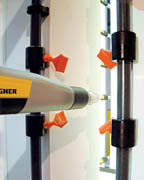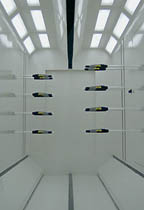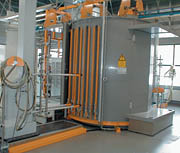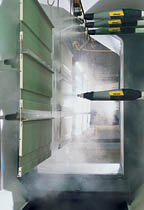

In the early stages of the industry, booths were designed as simple metal boxes to contain the process, without much regard for efficiency and color-change issues. As the industry matured, it became increasingly important to offer a variety of booth designs to fit different manufacturing situations and meet the challenges of cost, transfer efficiency and color-change options.

Fast color change
Color change is one area that has historically been a challenge for manufacturers considering switching to powder booths. "How fast can I change colors?" they ask. What the question really means is, "How long does it take to clean my system so there's no old powder left to contaminate the next color?" That's one of the concerns that has held back a number of finishers from switching to powder coatings.
The added labor cost and lost production value of lengthy color changes can mean the difference between success and failure for coating operations where frequent color change is a fact of life. Not long ago, color changes could take a couple of hours. Today, changing from one reclaim color to another can be done in a matter of minutes.
What has made this dramatic reduction in color-change time possible? Mainly it has been the amount of attention paid to making the equipment easier to clean. Here's a small sampling of some innovations that shave valuable time off the process.

The color-change road map
Any place that old powder can come in contact with new powder is a potential hotspot for contamination. Take a look at the route that powder follows in a powder system and you'll understand where improvements have been needed along the way.
First, powder is delivered to the system from boxes, and must be fluidized and pumped to the spray guns. Most of the powder sprayed from the gun goes on the parts-but some doesn't. This oversprayed powder must be collected for reuse or disposal. Powder is routed by airflow to a container. It may be moved from the container to a waste barrel or, in many cases, recirculated back to the delivery system.
Changing colors means having to remove all of the previous powder from the powder feed equipment, booth and recovery system. Booth manufacturers have worked diligently to create short cuts that reduce the time it takes to purge the spray guns, booth walls and recovery system of one powder so that another can be introduced without the risk of cross-contamination.

The powder supply system
The powder supply system starts with the source of the powder. The modern feed center (Figure 1) minimizes the amount of surfaces required to deliver powder and provides mechanisms for their easy cleanup. By centralizing the delivery apparatus, a single operator can easily inspect, clean and reconnect the delivery equipment for color change. The feed center provides this central cleanup location and contains the cleaning process to prevent migration of powder to the surrounding area.
Equipment is made more accessible by mounting it so that it can be pivoted into a convenient cleaning position and relocated precisely when finished. The feed center can be equipped to supply powder from bags, boxes, totes or any other type of powder container. Cleaning of the powder delivery system is much faster. Pickup tubes, pumps and hoses are purged with air from a manifold, eliminating the need for individual, manual cleaning of each line.
Another automated gun-cleaning feature is blow-off nozzles arranged around each gun barrel at the gun slots. As the guns are moved out of the booth, the air nozzles blow powder off of the gun barrel's exterior (Figure 2). The connections are at the end of a shaft that mounts to the back of the guns so the entire gun that is in the booth is smooth and free of connections. All of the connections remain outside of the booth and free of oversprayed powder (Figure 3).
When the cleaning cycle is enabled from the controls, the reciprocators move to a park position, aligning the air knives with the guns. Simultaneously, the in/out movers move the guns to full-in position. Then the air knives are triggered and the mover moves the guns to full-out position, passing the entire length of these smooth guns through the air knives and blowing them clean. These guns are available in various lengths, depending on booth width.

New powder booth designs
Another critical area of concern is the booth wall interior design and materials of construction. In the past, designers concerned themselves primarily with the mechanical aspects of the booth. They focused on how to make spray booths lighter, easier to install and more cost effective. These booth designers experimented with a range of commercially available materials, including painted steel, stainless steel and a variety of thermoplastic materials.
In the next phase of booth design, engineers began to design booths that were easier to clean, and provided much greater visibility for the coating applicators. This brought more clear plastics and composite materials into use. These newer surfaces are much easier to clean and designed to eliminate areas that will trap powder (Figure 4).
Everybody realizes that it's easier to clean a booth that's free of tight corners, seams and ledges where powder can accumulate. Existing booth materials are fashioned into better shapes to eliminate hard-to-clean areas. Sloped surfaces, even curved booth walls, have been integrated into the latest booth designs, such as the booths pictured in Figures 4 and 6.
The ITW Gema Magic Cylinder booth is designed for automatic coating environments with very fast color-change requirements. With the focus on automatic coating and fewer manual coating stations, the booth's footprint is kept small (Figure 6). Coating stations can be added to the booth cabin if needed for limited manual touch-up.
This type of booth interior is friendly for cleaning, due to the compact, cylindrical interior. With advanced control systems, much of the cleaning process is automated, providing the potential to consistently change colors in less than 15 minutes with only two technicians. The walls and ductwork in the booth are seamless, minimizing the risk of color contamination.

Recovery systems
Of course it is also critical to create recovery systems that lend themselves to reliable and fast cleaning.
Cyclone technology has been used for powder coating recovery systems for many years. Some of these early systems had problems with contamination in the ductwork and transfer pumps and issues with tight vessels in the cyclone and cartridge module. Newer cyclone systems have addressed these issues, as well as the recovery efficiency and overall material utilization to create systems that are color flexible and reasonably simple to clean. The seamless ductwork and improved cyclone design have made these systems simpler to clean with a higher percentage of recovered powder. The ITW Gema MagicPlus (Figure 7) system includes many of these features. Used with the smooth-walled interior, a color feed system and advanced controls for fast color change, the system provides an answer for systems that require five to 15 color changes a day in a single booth.
Some recent cyclone recovery systems have been designed to funnel oversprayed powder into a small chamber that's easy for operators to access for proper cleaning. The latest Nordson ColorMax booth takes ductwork cleaning further than ever. By opening a hinged door in the booth wall, an operator can actually access the cyclone ductwork (Figure 5). This provision makes complete cleanup of the ductwork a simple matter. Plus, the booth is designed to channel oversprayed powder to the collector through better airflow management.
In one recent booth design, the wall between the booth and collector can be opened for easy access to the interior of the collector. An operator opens a hinged panel inside the booth and has complete, unfettered access to clean the collector.

The significance of airflow
An area of booth design that has benefited from advances in computer-aided design tools is the analysis of airflow patterns and velocities inside the booth.
Air in a powder booth is necessary to create the negative pressure needed for containment of overspray. But it is important to avoid a strong airflow in the application area. The airflow that is needed to contain the powder within the booth and draw it to the collector may disturb the attraction of powder to the target part. Airflow around the part should be as gentle as possible to avoid significant loss of transfer efficiency.
Designing for better airflow has two objectives. First, a "quiet" zone must be created around the gun and the part so that electrostatics can draw powder to the part without being disrupted by air currents. And second, airflow should help to direct the oversprayed powder to the collection system. Many modern booth designs incorporate airflow patterns that maintain good containment of powder without creating turbulent airflow in the spray zone.
For example, the Supertech booth from Wagner Systems uses a full-length, dual downdraft design intake slot to distribute the airflow and move the intake point away from the application area (Figure 8).
Summary
In summary, fast color change requires a booth that can be cleaned quickly and easily. In the earliest days, when a powder booth was a big metal box to spray into, it was not regarded as critical to provide good transfer efficiency and fast color change. Recent advances have been made in the booth design, including better collectors and modern feed centers to enhance efficiency and create very fast color change within one booth.
Modern powder booths can optimize transfer efficiency with engineered airflow throughout the booth. New, specially designed composite materials offer the best combination of physical properties and clean-ability. These composites can be fabricated into shapes tailored to provide the best clean-ability and larger sections that eliminate joints and seams, and facilitate installation.
In addition to faster color change and improved efficiency, the booth manufacturers have worked hard to offer a wider variety of booths and recovery systems to meet every need and budget. Many historical limitations that used to challenge would-be powder coaters have been eliminated. Anyone who applies powder coating or is a potential candidate for powder coating should see the latest offerings at trade shows or at manufacturers' facilities. You just may be pleasantly surprised to find out what is available.

Report Abusive Comment